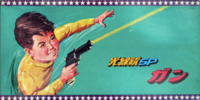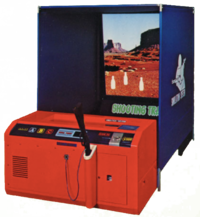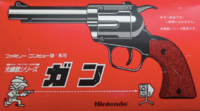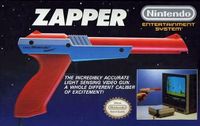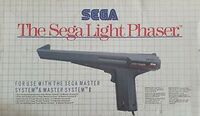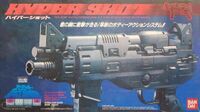Light gun
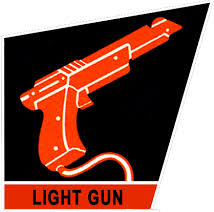
| |
| Light gun | |
| Developer | numerous, see below |
|---|---|
| Publisher | numerous, see below |
| Systems | numerous, see below |
| Released | 1936-present |
| Added to Museum | NES Zapper November 18, 2017 Beam Gun: Duck Hunt December 18, 2017 SMS Light Phaser June 5, 2019 Wii Zapper June 20, 2022 |
The light gun or lightgun is an accessory, modeled after a gun, that uses a sensor to detect light. The first light guns emitted light at electromechanical targets, while modern light guns are incorporated in video games.
Early light gun development
The first light gun was developed by Seeburg in their Ray-O-Lite arcade game line that first launched in 1936. The gameplay consisted of a gun that would emit a ray of light. On a target was a light-sensing tube, and the target would drop if the tube sensed the light, signaling a successful hit.
In 1970, Nintendo began developing their Beam Gun series of toys, utilizing a light gun designed by Masayuki Uemura. Once the trigger was pulled on the light gun, a flash would be detected by solar cell technology, which would record a hit. The first in the line, Beam Gun SP, had a range of 24 feet, whereas the second in the line, Beam Gun Custom, had a range of 300 feet.
Nintendo Simulation System
In 1971, Nintendo president Hiroshi Yamauchi wanted to expand their light gun toys into a shooting range simulation. He asked Gunpei Yokoi, who had created several successful toys for Nintendo, to create a simulation based on clay pigeon shooting.
Hiroshi Yamauchi intended for these shooting range simulations to be installed in vacant bowling alleys. After Americans brought bowling to Japan after they continued to live there after World War II, bowling became a popular Japanese pastime. The Japanese bowling fad was short-lived however, as by the 1970s, many bowling alleys were sitting abandoned. Nintendo purchased several of these bowling alleys with the intention to convert them into electronic shooting ranges. Gunpei Yokoi and Masayuki Uemura, together with Genyo Takeda, worked under the newly formed Nintendo Research & Development 1 division of Nintendo, and created a shooting gallery game to use in Nintendo's converted bowling alleys.
The result was the Laser Clay Shooting System, which consisted of a screen, with a film of clay pigeons broadcast on it over an overhead projector. In front was the lightgun, which when fired, a network of reflective surfaces would register whether the shot was a hit or a miss. The game was unveiled in 1973, however its first demonstration didn't work properly. Yokoi had to stand behind the screen, adding the score to the system manually. After its unveiling, the bug in the program was fixed, and the game worked perfectly for the rest of the time it was in operation.
After the 1973 Oil Crisis, Nintendo had to abandon its grand plans to use Japan's bowling alleys as electronic shooting ranges. They reduced the size of the system so that it could be sold as an arcade game. The Laser Clay Shooting System was adapted for the smaller setup and was sold to arcades as Mini Laser Clay. Sales for Nintendo's Simulation System started off slowly, but they gradually increased in volume, which led to Nintendo adapting the system for use with other 16-mm films. Six games were released in all, between 1974 and 1978.
In 1976, Beam Gun: Duck Hunt was released. This light gun game used projected targets, like the Simulation System games, but the system itself was much smaller due to the fact that it was intended for home use.
Nintendo Famicom Beam Gun
In 1983, Nintendo Research & Development 2 developed the Family Computer, or Famicom, video game console. Shortly after its release in Japan on July 15, 1983, Nintendo began to develop light gun games for use with it.
The Beam Gun Series Gun, a part of Nintendo's successful light gun toy line, was released on February 18, 1984.
As the pack-in game had a Wild West theme, it was designed to resemble a revolver.
Nintendo Entertainment System Zapper
The Nintendo light gun was released on the western counterpart of the Famicom, the Nintendo Entertainment System, in North America in 1985, and was renamed the Zapper. The Famicom Beam Gun resembled a revolver, but due to government restrictions in the United States, the Zapper was redesigned so that it would resemble a ray gun from science fiction.
In 1989, due to laws enacted in the United States that required imitation guns to have orange tips to distance themselves from real guns, the entire dark grey sections of the Zapper were changed to orange.
Sega Master System Light Phaser
The Sega Master System received its own light gun, the Sega Light Phaser, in North America in 1986, in Europe in 1987, and in Brazil in 1989. It was never released in Japan. The color of the Light Phasers had to be changed due to the laws about imitation guns that were enacted in the United States in 1989. However, unlike the Zapper, the color of the plastic was not changed. Sega simply began shipping Light Phasers with orange stickers around the tips. In addition, the company authorized to sell the Sega Master System in Brazil, Tec Toy, sold Light Phasers that were encased entirely in blue plastic rather than black.
Bandai Famicom Hyper Shot
Bandai released a machine gun peripheral for the Famicom titled the Hyper Shot in 1989.
The difference between the Beam Gun and the Hyper Shot was that the latter was set up for rapid-fire and that it contained a directional pad.
The Hyper Shot was compatible with Beam Gun games, however the built-in directional pad made it so that games designed for it required the Hyper Shot to play.
Wii Zapper
Traditional light gun video games use scanlines to determine if the light gun registered a hit, however, high-definition screens don't use scanlines. Wii Remotes utilize a sensor bar that allows for precise position tracking on Wii and Wii U. The Wii Zapper shell holds a Wii Remote and a Nunchuk together, for increased precision versus holding a Wii Remote with one hand. The Wii Zapper was released in Japan on October 25, 2007, in North America on November 19, 2007, in Europe on December 7, 2007, and in Australia on December 13, 2007.
